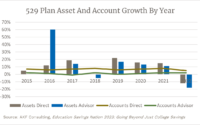States With Low Or No Capital Gains- How much will you in owe?
LAS VEGAS, NV – MAY 30: The strip on Las Vegas Boulevard is seen on May 30, 2002 in Las Vegas, … [+]
Many Americans are considering moving between states now, or once they’ve retired. The tax planner in me wants to make sure people know about the difference in the capital gains rates they may incur when moving from a low to a high-tax state or vice versa.
I recently spoke with a couple looking to move from Texas to California. To make the down payment on their dream home in the hills of Los Angeles, they faced a large capital gain tax bill once they sold highly appreciated stock. Realizing the capital gains while still residents of Texas, they would incur a much smaller state tax bill than making the same sales while living in California. Further tax planning strategies could also help them reduce the federal capital gains taxes.
We ended up helping them take a Securities Backed Line of Credit (SBLOC) to minimize both state taxes and federal gains taxes while still giving them the money for the down payment on their new home in Los Angeles. This strategy saved them over $100,000 in federal taxes while spreading and minimizing taxes at the state level.
Capital gains taxes may be fine for the average taxpayer from year to year. However, if you are selling a home, have highly appreciated investments, or have equity compensation, tax planning and being aware of capital gains rates between states can be extremely valuable.
For high income residents California may have the highest capital gains rate at 13.3%.
Does My State Have Low Capital Gains Taxes?
Wherever you live, your capital gains taxes will be the same at the federal level. Whereas capital gains tax rates will vary widely from state to state. If you live in California, you could owe as much as 13.3% on your capital gains, while your capital gains could be as low as zero percent in another state.
States With Low Capital Gains Tax Rates:
· While North Dakota treats capital gains as income, the 2023 state capital gains rate is just 2.9%. There is also an array of ways to exclude a portion of your capital gains from taxation if you are a resident filing taxes in North Dakota.
· Indiana is another example of a state with low capital gains tax rates. Capital gains are treated the same as regular income but taxed at the 3.23% flat tax rate.
· Pennsylvania’s flat income tax rate is 3.07%. Again, in PA, capital gains are taxed as regular income, regardless of whether they are short-term or long-term capital gains.
These are just a few examples of states with low capital gains taxes. Several other states have no capital gains taxes.
Wyoming is another state with no capital gains taxes.
States Without Capital Gains Taxes
Low capital gains taxes are great; no capital gains taxes are even better. I have some good news for Alaska, Florida, New Hampshire, Nevada, South Dakota, Tennessee, Texas, and Wyoming residents, which are all states without a capital gains tax.
These eight states also don’t have a personal income tax. This does not mean that these states’ overall tax burden is zero. Every state has to raise revenue somehow.
If you are considering moving, whether for a new job or retirement, make sure you are aware of the overall tax burden differences between your old and new states. Likewise, if you are facing large capital gains, be sure to work with a skilled tax-planning financial planner to ensure you are keeping as much of your hard-earned money as possible. The capital gains rates at the federal level are progressive, meaning they go up the more income you have.



